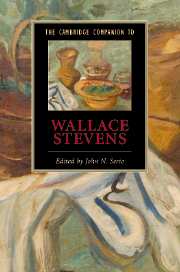Book contents
- Frontmatter
- Introduction
- 1 Wallace Stevens: A Likeness
- 2 Stevens and Harmonium
- 3 Stevens in the 1930s
- 4 Stevens and the supreme fiction
- 5 Stevens’ late poetry
- 6 Stevens and his contemporaries
- 7 Stevens and romanticism
- 8 Stevens and philosophy
- 9 Stevens’ seasonal cycles
- 10 Stevens and the lyric speaker
- 11 Stevens and linguistic structure
- 12 Stevens and painting
- 13 Stevens and the feminine
- 14 Stevens and belief
- Further reading
- Index
3 - Stevens in the 1930s
Published online by Cambridge University Press: 28 May 2007
- Frontmatter
- Introduction
- 1 Wallace Stevens: A Likeness
- 2 Stevens and Harmonium
- 3 Stevens in the 1930s
- 4 Stevens and the supreme fiction
- 5 Stevens’ late poetry
- 6 Stevens and his contemporaries
- 7 Stevens and romanticism
- 8 Stevens and philosophy
- 9 Stevens’ seasonal cycles
- 10 Stevens and the lyric speaker
- 11 Stevens and linguistic structure
- 12 Stevens and painting
- 13 Stevens and the feminine
- 14 Stevens and belief
- Further reading
- Index
Summary
Play the present
- “Mozart, 1935”Wallace Stevens ended his promising career as a poet once he published Harmonium in 1923. He had been a semi-active member of the New York avant-garde scene in the 1910s and early 1920s, and had helped Harriet Monroe's modernist venue Poetry get underway by publishing there several poems perfectly befitting the modernist mode. The poems in Harmonium are at turns luscious, sparely ironic, cubistic, rhetorically anti-rhetorical, post-Christian, and minimally meditative; several are brilliant verse exercises in modernist language philosophy. But it is said - no one really knows for certain - that his family and business lives finally held more interest for him than poetry. His was a brief career. Perhaps its implosion was predicted, even necessitated, by the irony and insularity of the poems.
The narrative above is wrong, of course, but it is not an unreasonable story one might have told about Wallace Stevens at the beginning of the 1930s.
- Type
- Chapter
- Information
- The Cambridge Companion to Wallace Stevens , pp. 37 - 47Publisher: Cambridge University PressPrint publication year: 2007

